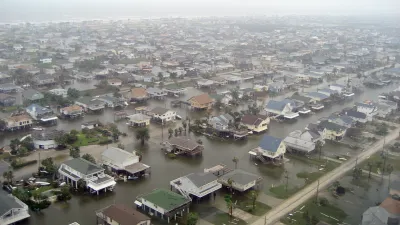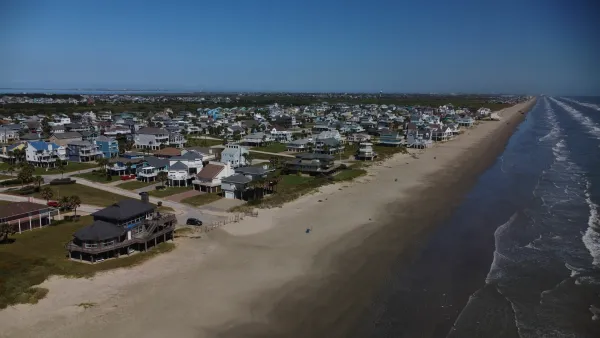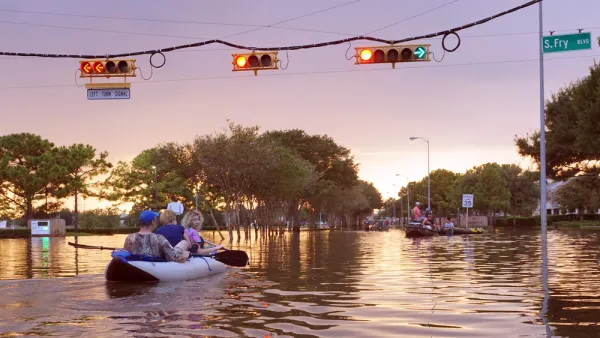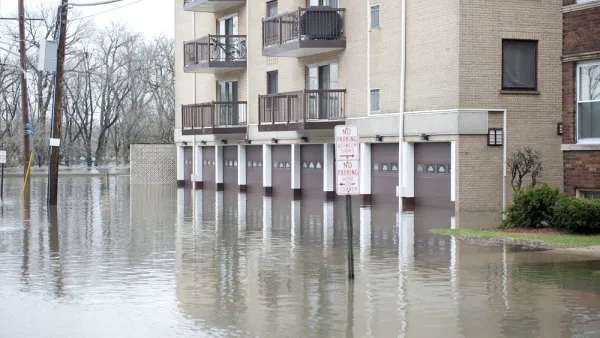Federal legislation and rising sea levels are changing the way homes are insured against flooding. According to this feature article, in fact, flood insurance "is serving as a kind of advance scout into a more difficult future."

Brooke Jarvis writes an in-depth feature article that examines the changing flood insurance industry. The central trope of the article—that flooding risk has already become flooding certainty in some parts of the country—is exemplified by the Hampton Roads Area of Virginia, where the sea level is rising as the land sinks, raising relative sea levels faster than anywhere else on the Atlantic Coast. Jarvis explains of the planning relevance of this story in the city of Norfolk:
The operative measurement for rising waters in Norfolk is not inches but feet — as many as six of them by the end of the century, according to the Army Corps of Engineers, though estimates vary. City planners are forthright that they’re preparing for a future in which parts of the city do not survive.
The extreme risks facing coastal communities are visible in the insurance industry, which is changing quickly in response to the more frequent floods brought about by rising sea levels and more extreme weather events, but also federal legislation known as. Biggert-Waters and Grimm-Waters, passed in 2012 and 2014, respectively. "The first law cut subsidies and phased out grandfathered rates so that premiums would start to reflect the true risk that properties…face — reaching what the N.F.I.P. calls 'actuarial soundness.' The second tried to slow the rate of those increases when it became clear how hard they would hit property owners," writes Jarvis.
The long-read article is the second in a series from the New York Times Magazine's climate issue. The article includes a lot more detail about the insurance industry, the land use implications of sea level rise, and the effect of federal legislation on how homeowners are addressing the challenges of climate change. Consider this article mandatory reading for planners, homeowners, and residents living in coastal areas.
For more coverage of insurance in a world of certain flooding, see a feature article about a Urban Land Institute report from 2013 and an article by ARUP from March 2017.
FULL STORY: When Rising Seas Transform Risk Into Certainty

Analysis: Cybertruck Fatality Rate Far Exceeds That of Ford Pinto
The Tesla Cybertruck was recalled seven times last year.

National Parks Layoffs Will Cause Communities to Lose Billions
Thousands of essential park workers were laid off this week, just before the busy spring break season.

Retro-silient?: America’s First “Eco-burb,” The Woodlands Turns 50
A master-planned community north of Houston offers lessons on green infrastructure and resilient design, but falls short of its founder’s lofty affordability and walkability goals.

Test News Post 1
This is a summary

Analysis: Cybertruck Fatality Rate Far Exceeds That of Ford Pinto
The Tesla Cybertruck was recalled seven times last year.

Test News Headline 46
Test for the image on the front page.
Urban Design for Planners 1: Software Tools
This six-course series explores essential urban design concepts using open source software and equips planners with the tools they need to participate fully in the urban design process.
Planning for Universal Design
Learn the tools for implementing Universal Design in planning regulations.
EMC Planning Group, Inc.
Planetizen
Planetizen
Mpact (formerly Rail~Volution)
Great Falls Development Authority, Inc.
HUDs Office of Policy Development and Research
NYU Wagner Graduate School of Public Service




























